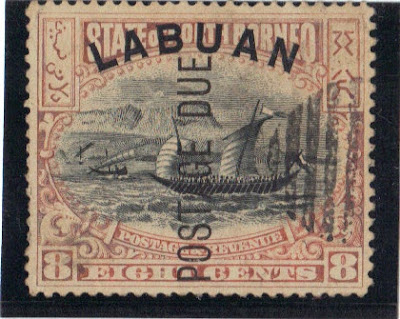This is an uncommon bar cancellation found on Brunei stamps. It is usually poorly defined. This example shows that this cancel probably consists of at least 8 and more likely 9 (as in other recorded examples) medium bars in the shape of an oval. The status of this marking is open to question.
It had been postulated this could have been a paquebot or arrival postmark for mail travelling to or via Labuan. This is smaller and rather different to the 9 bar cancellation of Labuan. And the use of bar cancellation for postage purposes in Labuan stopped in the early 1890s. This stamp was issued in 1907.
The other two possibilities are that this was some kind of fiscal or temporary cancellation but then why should it be confined to the lower value stamps of the 1907 series?
The quality of the marking would point to a temporary hand stamp that was not of normal construction with metal or rubber. It might also have been down to a particular ink or ink pad that was used.
A North Borneo type bar cancel on a 1901 Labuan postage due stamp seems a bit amazing. This is by no means an unusual marking having seen it several times on different Labuan stamps. My first impression was this is the Sandakan 14 bar cancel but on comparing directly, it is more akin to the 13 bar cancellation again from Sandakan. One has also to bear in mind that there is some variation in proportion of the 14 bar cancel and similarly and more obviously in the Labuan 9 bar cancel which has not been clearly documented so far.
And also the dates just do not tally. According to Proud, the 14 bar was used postally until 1891 and the 13 bar until 1886.
And then what is this stamp doing in Sandakan as postage dues were used at the local post office on payment for an underpaid postal item? Does that reflect the flexibility in the use of stamps of both territories when Labuan was ruled by the British North Borneo Chartered Company from 1890 to 1904?
The most likely explanation could be that, when this stamp was CTO in London for mass consumption, the wrong bar hand stamp was used. But then CTOs are usually found at the corners of stamps. The position of the cancellation would implied normal use. Could it be a fake? But that would not make any financial sense. The nature of this cancel remains unclear.
Incidentally, the most famous Labuan stamp is a variety of this 8c stamp with the frame inverted. Only 33 copies were recorded which were CTO (corner cancellation) at the London office. They were sold as part of a cheap package of stamps. The stamp would have had originated from a sheet of 50 or 100. It is quite possible that some are still undiscovered, lurking in someone's grandfather's schoolboy collection!
Update
I have found another better example recently. This one has 7 of the bars visible. I have the same stamp alongside with a normal Labuan bar cancel for comparison. The thinner bar stamp has gum!! This would suggest CTO rather than postal use and would have been carried out at the London printers. This bar cancel is closer to the 14 bar cancel even though it is not an exact fit. Is it a forged cancellation? But why bother?



I have a similar cancel on the 1888 Sarawak 12 Cents stamp!
ReplyDeleteSimon, I presume that is the Brunei 9 bar cancel. I have one Sarawak stamp with the Labuan bar cancel, much more uncommon.
Delete